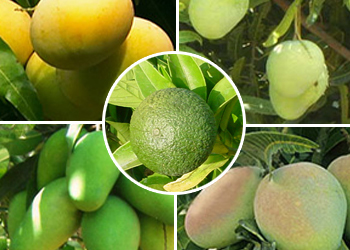ABOUT GOMANGO

GoMango provides you a very attractive, fresh & high-quality mango fruits at a very competitive price without comprising on the organic methodology for the best yield used in-house for evergreen tree with glossy, with dense foliage year on year as achievement to share with you all.
The passion for commitment & to produce the best has always challenged us to our constant endeavor on the quality yield & supply. Mangoes are seasonal fruits; fresh mango fruit season begins in the month of May, when the rich fragrance of the fruit heralds its arrival. We have been at the constant search on bettering our services rendered and the quality with our customer's valued feedback. Our endeavor is to produce outstanding-quality mangos for the consumers in the market who always want to purchase again and again requires a commitment to quality by each and every stakeholder involved in mango production and handling till its consumption stage by various industry. Harvesting the best mango & ensuring quality is identified under mango harvest and on ground practices are hinged on the improved strategies such as better determination of proper harvest maturity, segregation based on the variety production; post plucking ensuring better temperature management before hot water treatment, after hot water treatment suitably, logistics involving prior to shipping till it reaches the stakeholder's/ to the distribution centers; better packinghouse sorting and grading
of fruit; better packaging and palletizing of mangoes; and better management of retail mango displays.
Utmost personnel care at every step in the handling of fresh mangos contributes to supreme delivery of good quality and prolonged shelf life to customers. Therefore, minute attention to detail is required at all stages including stages for preparation and distribution. We address the typical problems and recommended best practices that will ensure delivery of the best possible quality mangos to your customers. We venture out based on the business propositions & requirements to aid the end user consumer by selling at most competitive prices to like wholesaler/retailer/middlemen etc. The prices are decided basis various parameters & they get benefited differently by purchasing mangoes from your orchard. This could be on assurance on quality, taste, texture, price of mangoes. It could also be on speedy delivery, easy and multiple choice of payments, EMIs for small retailers etc. Stakeholders can think of advance booking too by visiting the Orchard.
The Orchard is eco-friendly and we do it very differently by having the same by a naturally built boundary surrounded by coconut, Neem & nilgiris tress with some teaks. Various bird species are seen during the fruit bearing season & otherwise too, ensuring no wild animals/birds are harassed, or pestered, or pest animals/birds are managed through non-lethal methods, or leave a percentage of crop for their survival - usually 1-2% of unreachable fruits on the tree & other papaya, and black jamoon trees.
The approach on ensuring best quality fresh mangoes achieved milestone acclaimed year on year we would like to take you through the stages followed at various intervals.
Propagation
We have farmers should always get vegetatively propagated, true to type plants from recognized nurseries who have been trained & adept in grafting skills. Inarching, veneer grafting, side grafting and epicotyl grafting are the popular methods of propagation in mango time and tested.
Planting
Land has been chosen and has been segregated based on the sort of breed asin the fruit bearing & maintenance based on the fruit variety has been kept in mind while planting, hence hectares of land has been kept separate as per the yield at different yield. Each piece of land has been prepared by deep ploughing followed by harrowing and levelling with a gentle slope for good drainage. Spacing varies from 6 m x 6 m to 10m to 10 m depending on the breed again, in the dry zones where growth is less. New dwarf hybrids like Dussehar & alphonso has been planted at closer spacing. Pits are filled with original soil & red soil mixed with 20-25 kg well rotten locally generated manure, 2.5 kg single super phosphate and 1 kg muriate of potash. Its currently six year young & highly productive combined with significant growth tree. Plants has been connected with two pronged water supply one its been drip irrigated to ensure least water wastage & is been connected with line irrigation too. The complete farm is been fenced & well protected from external/stray animals & langoors with innovative mechanisms and customized devices designed to keep them at bay forever easy to operate & install.
Training and pruning
From time to time we have ensured one meter from the base on the main trunk should be kept free from branching and the main stem spaced at 20-25 cm apart in such a way that they grow in different directions. Branches which cross over/rub each other may be removed at pencil thickness. It has been so well maintained that it has taken a shape of ball with thick foliage & multiple branches for maximum yield year on year.
Irrigation
Entire farm is drip irrigated & external water housing reservoir catering for 15000 ltrs of water. Trees are watered frequently for proper establishment, irrigation at 10 to 15 days interval from fruit set to maturity is beneficial for improving yield. However, irrigation is discontinued and is not recommended for few months prior to flowering since it would be taken at the vegetative growth at the expense of flowering.
Inter cropping
It's been done considering the initial growth & nourishment for the new saplings planted for initial 3 years alternatively with to enhance the soil nutrition combined with natural vermin compost to nourish with legumes for short duration along with other intercrops depending on the agro-climatic factors of the region. All this were suitable meticulously planned the existing water and nutrient requirements of the saplings which were met separately.
Plant Protection
At our farm takes highest precautionary measures to ensure & curtail any damages by a large number of local pests, diseases and disorders to which mangoes are prone to & typically found and addressed in the below manner:
Fruit drop :
Regular irrigation during fruit development, timely and effective control of pests and diseases and spraying 20 ppm NAA at pea size of fruits. They are treated with pesticides & insecticides in addition to that regular pruning to keep tree free from unwanted foliage and fresh foliage.
Harvesting and yield :
The period from month of December to February is the time when mango tree in full flower is a sight to behold. Hybrid/Graft trees start bearing at the age of 4 - 6 years (20-50 fruits) to give optimum crop from 10-15th year which continues to increase upto the age of 40 years under good management which is our constant endeavor.
FACT ABOUT MANGO
Source: Nutrient data for this listing was provided by USDA SR-21. Each "~" indicates a missing or incomplete value.
Percent Daily Values (%DV) are for adults or children aged 4 or older, and are based on a 2,000 calorie reference diet. Your daily values may be higher or lower based on your individual needs.
Nutrition Data's Opinion, Completeness Score™, Fullness Factor™, Rating, Estimated Glycemic Load (eGL), and Better Choices Substitutions™ are editorial opinions of NutritionData.com, given without warranty, and are not intended to replace the advice of a nutritionist or health-care professional.








